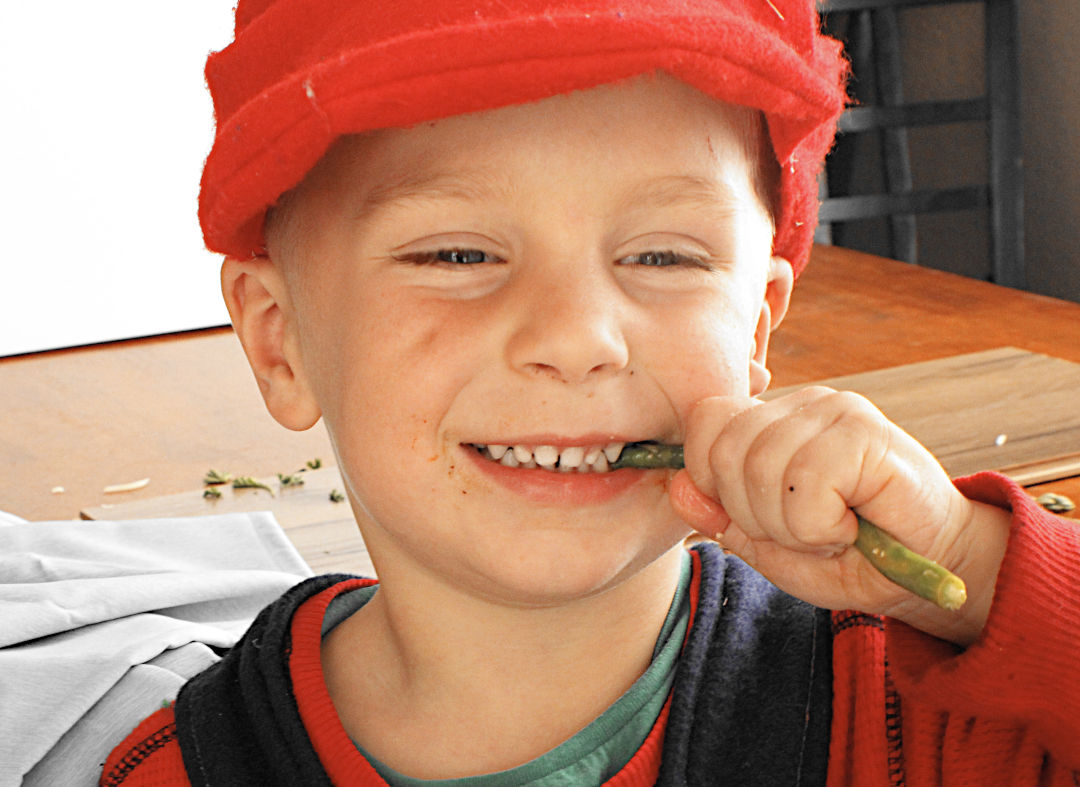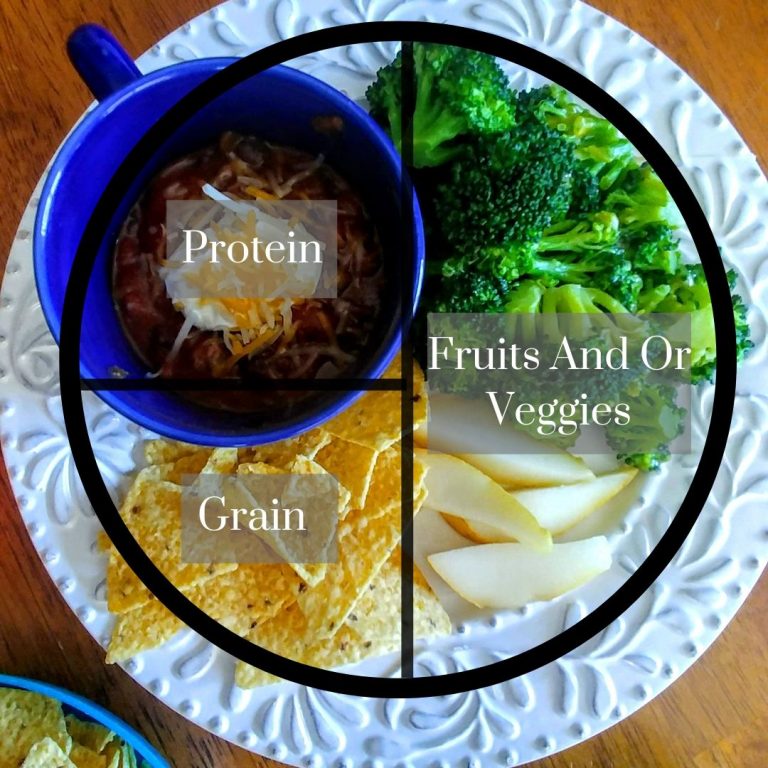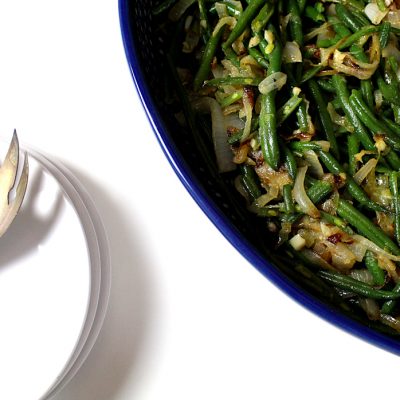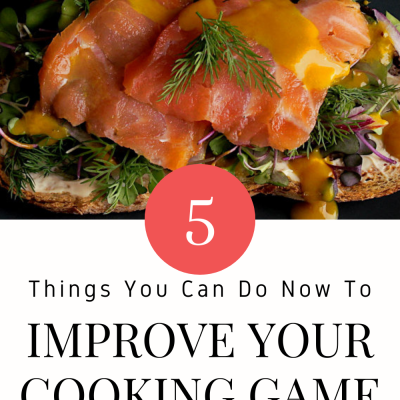Like most parents, I want to make sure my kids are getting the right nutrients into their bodies. I’m sure you’re here because you feel the same way. First let me say that most people are not perfect eaters. There are a few “Chris Treagers” that I’m sure most of us know, but for the most part many kids and (and adults) can have a hard time picking the asparagus over the cake. Here are some thoughts that have helped me and my family become healthier eaters. Don’t get me wrong, my kids aren’t perfect eaters in the least bit, and we’ve definitely had some fast food and cookie days. But overall, my kids do really well eating a wide variety of fruits, vegetables and more. I’m here to share with you some thoughts on how to help your kids, and maybe even some adults, become healthier eaters.
1 - Be An Example
If you want to have an impact on your kids then the biggest thing that you can do for them is to model eating well. This is a tried and true principle for more than just eating better. If you want your children to read more, then have them see you reading. If you want your kids to be hard workers, then let them watch you working hard. If you want your kids to eat that salad on their plate, then you should probably put down the soda and chips while you ask them.
Any age child, even adult children, still watch and learn from their parents. Practicing what you want to see in your kids can be more impactful in the long run then just asking it of them. Your kids are extremely observant and they learn from their parents every day. Even in those rebellious teen years, kids are still learning and watching their parents, even in they won’t admit to it. Does this mean you have to become a health guru? Absolutely not. Most people understand what is unhealthy food and which food is better to eat. Whole foods, grains, nuts, seeds, vegetables, fruits and food from scratch are universally seen as good for you. Focus on keeping it simple and find meals that are healthy that the whole family will love. Eat fruits and nuts for snacks. Have a smoothie over soda. Swap out chips for baked chips or crackers with some homemade guacamole dip. And most of all, be happy eating healthy.
2 - Don't make your kids finish their plates
This might seem like a strange one to begin with, but I can’t over emphasize the importance of this. You’re training your children to eat, correct? Well, in order for your kids to be healthy eaters they need to learn how to first, listen to their bodies. Many kids overeat mostly because well meaning parents ask them to finish everything that’s on their plate. As a result, kids ignore their bodies signals telling them that they are full, causing them to distrust their bodies and overeat.
Soon these kiddos become adults who don’t know how to eat a normal amount of food. They are so conditioned to overeat that they consume unnecessary calories that their typically less active adult bodies don’t need. They learn not to trust their bodies and are often overweight because of it. Your children need to understand what it feels like to be full, and when that happens they need to stop eating. Ironically, most kids know how to eat this way, it’s usually parents who are trying to get their children to be “good eaters” and to not be wasteful, that push theirs kids past their limits.
So how do I do this in my home? I ask my kids to eat until their tummies are full. That’s it. When they say they are done with dinner but still have food left over on their plate I ask, “Is your tummy full?”. If they finish their entire plate I ask, “Is your tummy full, or do you want some more?”. Most of the time my kids can answer this with the knowledge that they are indeed full, or maybe that they are little bit more hungry and want some more. There is one exception to this rule, and that is my sweet boy Kal. If any of you have a Kal, you’ll understand what I mean. My Kal loves to play, and eating often interferes with that. Especially because he’s a bit of a slow eater, which is a good thing, but not when you’re 3. His brother, however, is a fast eater, often finishing before Kal is done. So Kal, who has only eaten 2 bites of food and has been complaining that he’s hungry for the last 20 minutes, decides that his “tummy is full”, then I call BS on that! I then help to coach him to finish his food until he’s actually full, or until he’s eaten at least enough food to get him through until the next meal. The bottom line is, you know your kids and just do your best to help them be mindful eaters.
3 - Plate Method
This one is a tip that I got from a great Blogger – Pick Up Limes. She’s a vegan dietician who knows her stuff and is a great inspiration of mine. She’s got loads of helpful information on her website, and one of those that is both applicable to kids and adults alike is the plate method. So here’s the concept. Think of your plate in sections. Half of the plate should be full of fruits and/or veggies. A quarter of the plate should be a grain, preferably whole. And the remaining quarter should be a protein. This is such a simple way to ensure that your children are getting the correct proportions of food at every meal.
All too often does mac ‘n’ cheese show up with nothing else. How many times have your kids eaten chicken nuggets and juice for lunch? How about cheese and crackers. Ramen? Again, we are training our children to be complete eaters, and that means more veggies and fruit. If you have a very picky eater and are starting this journey wincing, might I suggest that you offer a fruit and veggie at every meal for children. Often times at dinner, fruits don’t really make their appearance. For adults that’s probably fine, but for kids fruit is usually easier for them to eat. If half of their plate is broccoli, they may not eat that much and it might overwhelm them. But if a quarter is broccoli, and a quarter is pears, then it might be more manageable for them to consume it. Fruits and vegetables have vitamins and minerals that our children need, so the more the merrier.
4 - Finish Fruits and Veggies 1st...If possible
When I give my children their plates, I try and ask them to eat their fruits and veggies first. This is more of a suggestion than an order. Sometimes I even serve it first while the rest of the food is getting ready. I try and educate my children, explaining to them that a healthy, strong body that wants to run and play all day needs fruits and veggies. I don’t preach or bore them to death with facts, but I try and make my point short and relatable. Knowledge is power, and I believe in empowering my children. Don’t sweat it if they choose not to. After all, it’s their body and they are in charge of it. But I continue to try to support this notion.
If that doesn’t work, then try and instruct them like this, “I don’t care if you finish your rice and beans, but I need you to eat most or all of your broccoli please”. In this way you’re still supporting that they listen to their bodies and don’t overeat, but you’re also trying to help them eat their fruits and veg as much as possible. If that doesn’t work and I notice that my children are only eating their grains and protein portions of the meal, I ask them to have at least 3 bites of their fruits and veggies. I don’t want my kids to overeat, but I do think that they need help making healthy choices. I try not to be naggy about it, just lovingly firm to help them learn how to be good eaters. Try not to make it a fight. We want meal time to be a positive and fun experience. I’ll admit that I’ve had a few food feuds with Kal that I’m not proud of. Don’t beat yourself up if this happens to you. Just do your best, stand your ground when you can, and let it go when you can’t. You won’t win every choice that your kids make, so just do your best. You’re kids won’t be perfect eaters…I was going to say overnight, but I’ll say ever. They won’t be perfect eaters ever. Are you? And that’s ok! We’re just trying to make small daily improvements that over time will benefit your kid’s health.
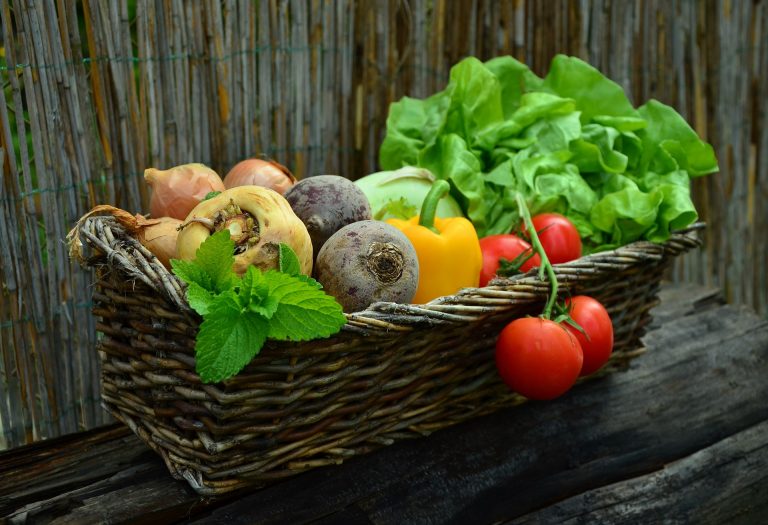
5 - Understand Food Exposure Theory
The first time I ever had curry was in college. I remember hating it. It was the weirdest flavor that I had ever tried. So weird in fact that my tastebuds couldn’t process what I was eating. I immediately stopped eating it and took it home out of the principle of not wasting food or money. The next day I thought to give it another try. I warmed a little up and had a few bites. Still, it was odd, but it wasn’t as bad as I had remembered. This carried onto the next day, but this time I actually started to enjoy the flavor. A week went by where I didn’t eat the curry and all of the sudden my mouth started to crave it. I went to get more and to my surprise I was in heaven! I couldn’t get enough. I consumed the entire bowl that night. The only thing I can contribute to this change is exposure to new flavors. Have you ever heard that it takes 10 times to try something to understand whether or not you like it?
I believe that exposure to food over time helps us enjoy something that maybe we didn’t like before. Sometimes I believe it even takes longer than 10 tries. I used to loath mushrooms. Throughout my life I would avoid them like the plague. It wasn’t until I was in my 20’s that I started liking them and now I love them! Regardless, the point is that helping your kids have a wider love for foods takes time, exposure and persistence.
Think about a child’s experience with food from day 1. They first thing a baby eats is breastmilk/formula. It’s sweet, mildly flavored, and a liquid. They eat this for at least 4 months. Some babies don’t even eat real food until they are 6 months old. But think about the overwhelming taste and texture, whether it be delightful or awful, that those first few foods have for a baby. That exposure to new foods and flavors doesn’t stop as a baby, but carries on well into adult years. Even still as an adult I am experiencing new flavors and textures. So don’t get discouraged if your children don’t like a certain fruit or veggie. Just keep at it. A good example of this is the meal pictured in this post. My sweet Kal (can you tell he’s my picky one) would not eat my Chinese eggplant meal. I on the other hand love making this meal and it is a family staple. Sure enough, after exposure and persistence, he eats it no problem.
There’s one bit of advice that I’ve picked up in my lifetime, and that is, “3 bites to learn to like it”. I love this advice because again, we are teaching our children to be good eaters. If there is something that your kids don’t like, tell them that we are learning to eat that particular food, and have them take at least 3 bites, or even 1 bite, heck, how about a lick! Any progress is good progress. Try to not make it a food fight. Keep your cool and just inform them that we’re working on learning how to like all kinds of foods and that this is simply the process. You’re kids may put up a fight, but you don’t have to join in. Don’t feel discouraged, keep calm, and keep at it.
6 - Know their limits...and yours
This guideline needs to come after number 5. Understand that your child has limits, so push but don’t shove. There is a fine line between exposing your child and helping them to try new foods, and forcing them to eat if it’s the last thing you do! Unfortunately I’ve actually been there. It was dinner time and yup, you guessed it! My 3 year old Kal. He just didn’t want to eat anything. He would moan and drag his fork slowly over the food, trying to delay eating as long as possible. We all finished our dinner and he hadn’t even begun! I told him that he needed to have some of his veggies and he asked me for help. So I picked up his fork and tried to feed him just to have him pull away. He’d open his mouth up again, and I’d try again, and he’d pull away again. After sitting there for what felt like an eternity, for him it probably was, I got really angry and scolded him for not eating and yelled at him to leave the table. “No soup for you!”. Internally I was fuming mad and feeling useless that I had just yelled at my kid for skipping a meal. I’m sure he wasn’t feeling too good about himself either at that point.
Now this may sound like a harmless story, but the feeling I had and he had were detrimental to the learning process. That’s what I have a problem with. I knew that I needed to let go of my feelings over that meal. I knew that I had reached my limit. I knew that I never wanted to get back to feeling that upset over food, and that next time I wouldn’t go that far. So on those occasions when Kal puts up a fight, I try and gauge just how set he is in not eating. If I feel like I’m getting upset or that this could turn into a fight, I let it go, kiss him on the forehead, and tell him he can be done. I also, just in case he gets hungry, keep the plate of food on the counter. If he comes begging for food in 30 minutes I’m not making him another meal. I calmly tell him this is what he can eat. Eventually this sinks in and no one has to fight.
Another thing to understand is that it’s ok if your child doesn’t like EVERYTHING. We are all shooting for our kids to be well rounded eaters and to eat most everything we give them, but they still will have opinions and tastes. Remember that it took me 20ish years to learn to like mushrooms! Don’t get too down on yourself if your child doesn’t like everything that you make for dinner every day. Just keep working at exposure and encouragement. They may never love mushrooms or kale or whatever, but your constant guidance will give them an opportunity to possibly like it someday. Much more than if you hadn’t.
bE KID FRIENDLY
I have a dear friend and bless her heart, she is really trying to take better care of her body by eating better. Her only problem is, her husband and her baby are very picky eaters. She told me that the other night, in attempts to please everyone, that she made 3 separate dinners. 3! That’s enough to make some hair fall out, especially if this is happening on the reg. My plea to all of you is to stop doing this. I feed my kids, and spouse, what I eat. I make one meal, that’s it. I’m not a selfish mom, I do ask for input and cook meals that we all love, but occasionally I know I’m going to get a few eye rolls. If we give into our children’s strict food guidelines, we are only fanning the flames to a future picky eater that is difficult to please and isn’t well rounded nutritionally.
Sometimes though I will say that we need to make food a bit more “kid friendly”. I’m not talking about creating only kids food, I mean have you seen my recipes here? That’s what my family truly eats! No, what I’m talking about is adjusting the texture, or shape of what you are making so it makes it easier or more fun for kids to consume. Here’s an example: As a baby, my eldest boy Gael was fed salad. He had little to no teeth at the time, but salad he ate. How did I do it? I diced the heck out of that salad! I had this amazing instrument called a “food chopper” which chopped up his food so small that he didn’t need to chew it. It essentially did the chewing for him. Another great tip is blending food. When I make soup that is
filled to the brim with kale, carrots or the like, I take half of it and I blitz it up in a blender. I take two bowls of soup and fill them up, one smooth and one chunky. My kids are much more likely to eat a smooth soup, than a chunky veggie soup, especially if kale is involved. I also make it extra fun to eat by telling them it’s monster soup. This makes them want to eat it all the more. Add a straw to that not so appetizing, yet you know once they taste it they’ll love it, green smoothie. Maybe cut things up into bite sized pieces for them. Look up “bento box” meals and see how creative and fun a lunch can be that will make them want to dig in because it looks fun to eat. Be creative and help your kids along.
7 - NO More giving into tantrums
I have tons of friends and family members who only make their kids pizza and chicken nuggets because, “it’s the only thing they’ll eat!”. First off, that’s not true. It may be the only thing they want to eat, but it’s not the only thing that they are able to eat. When we give into our kid’s picky eating habits, we are doing 2 things: 1 – We are sending our kids the message that they can get whatever they want as long as they can hold out or complain enough, and 2 – We are making them more of a picky eater by not giving them an opportunity to learn what else they like.
So here’s the suggestion that I would make. If I notice that my kids are eating more of something like cookies or candy, and that it begins to be all they want to eat, I cut them off, like an addict, cold turkey. This may sound harsh and cruel, and believe me I hear it. But if I continue to let my kids eat this way, they they will never want to eat anything else I give them. If all you wanted to eat all day was pizza, so that’s what mama gave ya, then ya, as a kid that’s what you’re going to do. Apples? Nah! Carrots sticks, ha! Are you serious? You are the parent and you get to help your kids find balance. So what’s the worry? They’ll starve? No. Your kids won’t starve. They may cry, throw a tantrum, get angry, scream! They may not even eat dinner for the next little while. But your kid’s desire to eat will soon outweigh their anger. So what do you do during the tantrums? Certainly not yell, you’re just giving into their emotions and they love it when they get you to lose it. You simply and unemotionally tell them that they aren’t going to be eating those things for a while. If they ask why, you can take this time to very calmly and lovingly tell them that it’s time to learn how to eat more than just pizza. It’s time to help our bodies by giving it healthy food that’s also yummy. It’s time to figure out what else we like. And last but not least, it’s time to teach our tastebuds how to like foods we don’t yet like. Take heart when kids begin to scream or throw a fit. When my kids are screaming and kicking then I know that change is about to come. If they are cool and don’t care, then that’s when I know I’m in trouble and I’ve got to change my tactics. Don’t give into whining and whimpering. I don’t care if it’s daddy’s little princess or a mama’s boy. You stand your ground and don’t serve that food for a while.
So does that mean no more pizza night?! Of course not. What it means is that pizza night is on reserve as a special dinner. Once your kids have started making progress and have eaten other dinners besides “the favorite”, then yes, treat them with their favorite meal. I’m sure you can think of your favorite meal, but do you have it every day? Heck no! Help your kids understand this.
8 - Have healthy snacks out on display

This tip is short and sweet but affective! If you have ready prepared foods on your table, your kids will eat it. Plain and simple. My Kal loves olives! So, on occasion I’ll leave out a bowl of olives, and sure enough, he’ll pick through it for a little snack. The same goes with cut up apples, carrot sticks, pistachios, crackers and bean dip, peanut butter pretzels, the list goes on! What ever you want your kids to snack on, have it readily available for them.
If you’re a family that’s gone most of the day and doesn’t have the chance to cut up an apple at 3:00 pm for an afternoon snack, keep some healthy snacks in the fridge and let your kids know what is there. They are much more likely to grab food they know exists and has been prepared for them. This could be as simple as designating a bottom drawer or space in your fridge with some bags of anything listed above and more.
9 - Understanding children's appetites
My big boy Gael (5 years) is one of the best eaters I know. He listens to his body when he’s hungry or full. He eats almost all of the fruits and veggies I serve him, and he’s definitely not a picky eater. Because of this I can trust him, and I’ve noticed something about his eating habits. They come in waves. Most the time he eats normally, but on occasion he’ll either eat nothing, like skipping dinner, or he’ll eat more than double his regular portion. one time he ate an entire Costco hotdog and pizza slice all by himself! That’s hard for me as an adult!
That meal was definitely not balanced, but on occasion that’s ok. The point is, kids are growing. Their appetites change with their growth. Sometimes they may not want to eat that much, or anything. That’s ok. Just make sure that when they do eat next, it’s not junk food or sweets. If they think they can skip meals just to have a cookie an hour later they’ll make it a habit. Help them have something healthy to eat as they will probably be pretty hungry again. Here comes that wave!
10 - Reduce PRocessed Foods

When Gael, my oldest, was a baby and was beginning to eat solid foods I thought a lot about what I was going to feed him. I had seen oatmeal baby food before and to me it looked like over processed fish flakes that had all of it’s nutrients leeched out of it. I didn’t want to feed my baby that! What was wrong with real oatmeal??? It’s mushy enough to not choke on it, even for a new eater. I tried it out, fed it to him, and he did great! No problem at all. And I felt much better feeding my son something a bit more wholesome. At that point I decided that I was going to focus feeding my son and future children whole foods that weren’t over processed.
Why is this important to raising a good eater? If all we are feeding our children is over processed foods that come out of a box, they 1 – aren’t getting wholesome nutritious foods, and 2 – Will become accustomed to artificial foods. In my opinion, this is one of the biggest reasons why my kids are such great eaters, even Kal. So does that mean that since you haven’t fed your child from birth unprocessed whole foods that they’re doomed for eternity?! Absolutely not. What it means is that you need to make the change ASAP. Help your kids learn how to cook. Try getting the most whole of that particular food that you can get. For example: Oats. There’s prepackaged and seasoned, quick, rolled/old fashioned, Irish and steel cut. Prepackaged and already seasoned oats have a set amount of sweetener to it which you can’t adjust. They also have a few more ingredients that we don’t want in our foods like calcium carbonate, guar gum or caramel color. Nope, don’t need em. Quick oats are the most processed of the oats. It cooks in 2 minutes and it better than buying already seasoned oatmeal packets but still not a great option. Next are old fashioned or rolled oats. These are pretty good and a regular staple in our home. Next is Irish oats, which are basically steel cut oats but cut in half to make cooking time faster. Steel cut oats are oats that haven’t been rolled. They are as whole as you can get. We eat this on occasion and love the chewy texture. Bottom line, try your best to cook your meals from scratch and limit the amount of processed foods you have in your home.
I know this can be difficult, but not as difficult as you think. Eating vegetarian for a few nights a week cuts down cooking time on average to about 15-20 minutes a meal. That’s shorter than getting in the car and going through a drive through, not to mention it’s much cheaper. Crock pots are a great choice for someone who can’t cook every night. Before you go to bed prepare the crock pot and put it in the fridge. The next morning take it out and cook it on low.
Bottom line, feed your kids real food. It’s what their bodies were meant to eat. It will help them be less picky in the long run and it will teach them how to create and cook food that they will love to eat as they grow up.
You Got this!
You child is watching you more than you know. I know that I still watch every move my parents make, and I’m 34! Being a forever good example is a great way to education and lead your child. Don’t freak out! Forever good example doesn’t mean perfect example, it means consistent. Think about the plate method when you are making a meal for yourself. Think about stopping to eat when your are full. Think about eating only 1 sweet thing or junk food thing a day. Think about eating your veggies 1st and finishing them. Your children are much more likely to listen to you if you are practicing what you preach. Be grateful for food and love it. Be a happy eater who loves to try new things, even if you still haven’t learned to like mushrooms yet. Take time to enjoy your food and your children by sitting down with them and eating all together as often as possible. Make meal time sacred (and yes, sometimes sacred gets a little loud).


